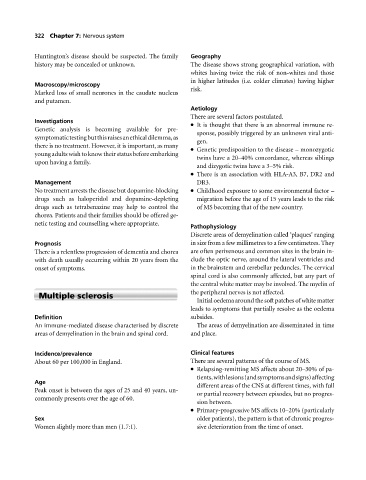Page 326 - Medicine and Surgery
P. 326
P1: FAW
BLUK007-07 BLUK007-Kendall May 25, 2005 18:18 Char Count= 0
322 Chapter 7: Nervous system
Huntington’s disease should be suspected. The family Geography
history may be concealed or unknown. The disease shows strong geographical variation, with
whites having twice the risk of non-whites and those
in higher latitudes (i.e. colder climates) having higher
Macroscopy/microscopy
risk.
Marked loss of small neurones in the caudate nucleus
and putamen.
Aetiology
There are several factors postulated.
Investigations
It is thought that there is an abnormal immune re-
Genetic analysis is becoming available for pre-
sponse, possibly triggered by an unknown viral anti-
symptomatictestingbutthisraisesanethicaldilemma,as
gen.
there is no treatment. However, it is important, as many
Genetic predisposition to the disease – monozygotic
young adults wish to know their status before embarking
twins have a 20–40% concordance, whereas siblings
upon having a family.
and dizygotic twins have a 3–5% risk.
There is an association with HLA-A3, B7, DR2 and
Management DR3.
No treatment arrests the disease but dopamine-blocking Childhood exposure to some environmental factor –
drugs such as haloperidol and dopamine-depleting migration before the age of 15 years leads to the risk
drugs such as tetrabenazine may help to control the of MS becoming that of the new country.
chorea. Patients and their families should be offered ge-
netic testing and counselling where appropriate.
Pathophysiology
Discrete areas of demyelination called ‘plaques’ ranging
Prognosis in size from a few millimetres to a few centimetres. They
There is a relentless progression of dementia and chorea are often perivenous and common sites in the brain in-
with death usually occurring within 20 years from the clude the optic nerve, around the lateral ventricles and
onset of symptoms. in the brainstem and cerebellar peduncles. The cervical
spinal cord is also commonly affected, but any part of
the central white matter may be involved. The myelin of
the peripheral nerves is not affected.
Multiple sclerosis
Initial oedema around the soft patches of white matter
leads to symptoms that partially resolve as the oedema
Definition subsides.
An immune-mediated disease characterised by discrete The areas of demyelination are disseminated in time
areas of demyelination in the brain and spinal cord. and place.
Incidence/prevalence Clinical features
About 60 per 100,000 in England. There are several patterns of the course of MS.
Relapsing-remitting MS affects about 20–30% of pa-
tients,withlesions(andsymptomsandsigns)affecting
Age
different areas of the CNS at different times, with full
Peak onset is between the ages of 25 and 40 years, un-
or partial recovery between episodes, but no progres-
commonly presents over the age of 60.
sion between.
Primary-progressive MS affects 10–20% (particularly
Sex older patients), the pattern is that of chronic progres-
Women slightly more than men (1.7:1). sive deterioration from the time of onset.

